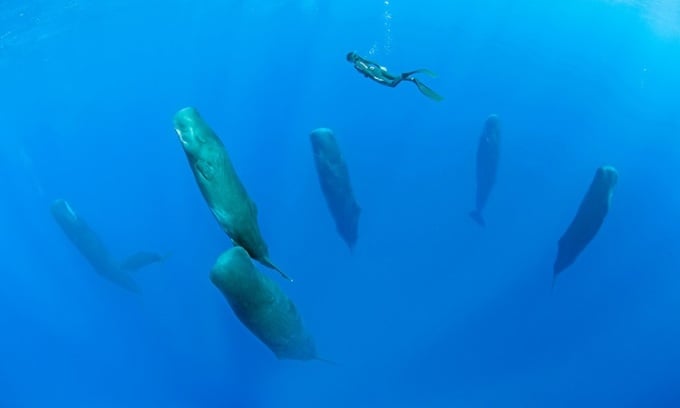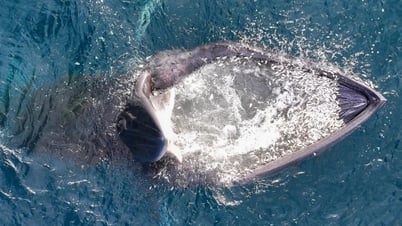Some marine mammals, such as dolphins, choose to sleep with half their brains in the air, while sperm whales sleep upright in the ocean.

Sperm whales sleep upright for short periods. Photo: Franco Banfi
If marine mammals want to sleep, they can't just close their eyes and drift aimlessly through the night, because they need to surface mid-night to breathe. They also can't just float and sink to sleep due to the risk of encountering predators and hypothermia, according to Live Science .
One solution is to deactivate half of the brain at a time. Called monohemispheric sleep, it's how marine mammals like dolphins rest in the open ocean. "Monohemispheric sleep is really helpful for these animals because it allows them to maintain low activity levels while still sleeping half of their brain at a time," says Patrick Miller, a biologist at the University of St Andrews in England.
Dolphins are the most studied marine mammals capable of this type of sleep. Brain scans of captive dolphins show that while one hemisphere experiences deep slow-wave sleep, the other remains awake, allowing the animal to sleep with one eye open. This type of sleep is quite common in the suborder cephalopods, a group of mammals that includes dolphins, whales, and porpoises. Many birds also use monohemispheric sleep for rest during flight.
But according to Miller, birds and dolphins use half-brain sleep for different purposes. For example, in a flock of birds, many on the outer edge keep their eyes open on the side furthest from the flock to watch for predators. Dolphins do the opposite. When sleeping, they usually keep their eyes open on the side facing the rest of the flock, most likely to avoid being separated.
Not all species in the suborder of whales sleep in a single hemisphere. Some species use a bispheric sleep system, where both hemispheres of the brain are asleep, like humans and most other mammals. "It's really difficult to measure brain activity in marine animals that you can't catch, like sperm whales, blue whales, or humpback whales. In that case, behavioral data is the best clue about their sleeping behavior," Miller shared.
Researchers can then tag the animals to track their behavior. A 2008 study by Miller used tags attached to sperm whales ( Physeter macrocephalus ) to show that they sleep in short bursts in the mid-ocean. Sperm whales dive close to the surface, slow down, stop, and sleep upright. Their upright sleeping position is likely due to a type of floating oil called spermaceti in their heads.
While sleeping, entire pods of sperm whales keep their heads facing upwards, close to the surface of the sea. Throughout this time, the animals remain completely unresponsive, indicating they are experiencing a form of deep sleep. However, sperm whales can only sleep underwater for about 20 minutes before they must surface to breathe. After breathing, they sink back under the sea to rest further, and this behavior can continue for up to 3.5 hours.
The northern elephant seal ( Mirounga angustirostris ) also sleeps with both hemispheres in similar short turns. A 2023 study by Jessica Kendall-Bar, a postdoctoral researcher at the Scripps Institution of Oceanography , University of California, San Diego, was the first to measure brain activity in marine mammals that sleep. Kendall-Bar and colleagues found that the seals dived to depths of about 300 m. There, their brains slowed down and they entered rapid eye movement sleep. They flipped over and spun in slow circles while continuing to sleep.
Due to the threat from predators, elephant seals limit their total time sleeping at sea to about two hours a day, placing them among the least sleeping mammals.
An Khang (According to Live Science )
Source link


![[Photo] Closing Ceremony of the 10th Session of the 15th National Assembly](/_next/image?url=https%3A%2F%2Fvphoto.vietnam.vn%2Fthumb%2F1200x675%2Fvietnam%2Fresource%2FIMAGE%2F2025%2F12%2F11%2F1765448959967_image-1437-jpg.webp&w=3840&q=75)

![[Photo] Prime Minister Pham Minh Chinh holds a phone call with the CEO of Russia's Rosatom Corporation.](/_next/image?url=https%3A%2F%2Fvphoto.vietnam.vn%2Fthumb%2F1200x675%2Fvietnam%2Fresource%2FIMAGE%2F2025%2F12%2F11%2F1765464552365_dsc-5295-jpg.webp&w=3840&q=75)



















































![[OFFICIAL] MISA GROUP ANNOUNCES ITS PIONEERING BRAND POSITIONING IN BUILDING AGENTIC AI FOR BUSINESSES, HOUSEHOLDS, AND THE GOVERNMENT](https://vphoto.vietnam.vn/thumb/402x226/vietnam/resource/IMAGE/2025/12/11/1765444754256_agentic-ai_postfb-scaled.png)




















































Comment (0)